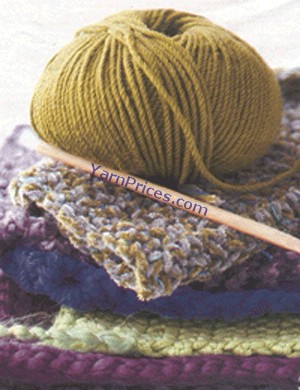|
Yarn is a long continuous length of
interlocked fibres, suitable for use in the production of
textiles, sewing, crocheting, knitting, weaving, embroidery
and ropemaking. Thread is a type of yarn intended for sewing
by hand or machine. Modern manufactured sewing threads may
be finished with wax or other lubricants to withstand the
stresses involved in sewing. Embroidery threads are
yarns specifically designed for hand or machine embroidery.
Structure of Yarn Spun yarn is made by twisting or otherwise bonding staple fibres together to make a cohesive thread. Twisting fibres into yarn in the process called spinning can be dated back to the Upper Paleolithic, and yarn spinning was one of the very first processes to be industrialized. Spun yarns may contain a single type of fibre, or be a blend of various types. Combining synthetic fibres (which can have high strength, lustre, and fire retardant qualities) with natural fibres (which have good water absorbency and skin comforting qualities) is very common. The most widely used blends are cotton-polyester and wool-acrylic fibre blends. Blends of different natural fibres are common too, especially with more expensive fibers such as alpaca, angora and cashmere. Yarns are made up of a number of plies, each ply being a single spun yarn. These single plies of yarn are twisted together (plied) in the opposite direction to make a thicker yarn. Depending on the direction of this final twist, the yarn will be known as s-twist or z-twist. For a single ply, the direction of the final twist is the same as its original twist. Filament yarn consists of filament fibres (very long continuous fibres) either twisted together or only grouped together. Thicker monofilaments are typically used for industrial purposes rather than fabric production or decoration. Silk is a natural filament, and synthetic filament yarns are used to produce silk-like effects. Texturized yarns are made by a process of air texturizing (sometimes referred to as taslanizing), which combines multiple filament yarns into a yarn with some of the characteristics of spun yarns. Yarn Measurements Yarn quantities are usually measured by weight in ounces or grams. In the United States, Canada and Europe, balls of yarn for handcrafts are sold by weight. Common sizes include 25g, 50g, and 100g skeins. Some companies also primarily measure in ounces with common sizes being three-ounce, four-ounce, six-ounce, and eight-ounce skeins. These measurements are taken at a standard temperature and humidity, because yarn can absorb moisture from the air. The actual length of the yarn contained in a ball or skein can vary due to the inherent heaviness of the fiber and the thickness of the strand; for instance, a 50 g skein of lace weight mohair may contain several hundred meters, while a 50g skein of bulky wool may contain only 60 meters. There are several thicknesses of yarn, also referred to as weight. This is not to be confused with the measurement and/or weight listed above. The Craft Yarn Council of America is making an effort to promote a standardized industry system for measuring this, numbering the weights from 1 (finest) to 6 (heaviest). Some of the names for the various weights of yarn from finest to thickest are called lace, fingering, sport, double-knit (or DK), worsted, aran (or heavy worsted), bulky, and super-bulky. This naming convention is more descriptive than precise; fiber artists disagree about where on the continuum each lies, and the precise relationships between the sizes. A more precise measurement of yarn weight, often used by weavers, is wraps per inch (wpi). The yarn is wrapped snugly around a ruler and the number of wraps that fit in an inch are counted. Labels on yarn for handicrafts often include information on gauge, known in the UK as tension, which is a measurement of how many stitches and rows are produced per inch or per cm on a specified size of knitting needle or crochet hook. The proposed standardization uses a four-by-four inch/ten-by-ten cm knitted or crocheted square, with the resultant number of stitches across and rows high made by the suggested tools on the label to determine the gauge. In Europe textile engineers often use the unit tex, which is the weight in grams of a kilometre of yarn, or decitex, which is a finer measurement corresponding to the weight in grams of 10 km of yarn. Many other units have been used over time by different industries. The following resources had contributed to the definition:
The above yarn definition was retrieved from Wikipedia June 14, 2011 from the yarn definition page at https://en.wikipedia.org/wiki/yarn. The definition has been modified by the Yarn Prices website (Apparel Search Company). Return to the Yarn Prices main page.  Yarn Prices
Yarn may be used undyed, or may be colored
with natural or artificial dyes. Most yarns have a single uniform
hue, but there is also a wide selection of variegated yarns:
|